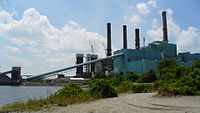
Photo from wikipedia
Abstract Land surface temperature (LST) is an essential indicator of the Earth's surface energy budget. It is essential for urban micro-climate change studies and acts as a controlling variable in… Click to show full abstract
Abstract Land surface temperature (LST) is an essential indicator of the Earth's surface energy budget. It is essential for urban micro-climate change studies and acts as a controlling variable in climatic models. The present study, LST retrieves with the improved mono-window algorithm from the Landsat-8 Thermal Infrared Sensor Band 10. The proportion of vegetation cover coupled with Normalized Difference Vegetation Index (NDVI) used for the estimation of emissivity. The derived emissivity and surface temperature over different ground features have compared with field observation as well as those in the literature and found in an accepted range (error of around 1–2%). Herein, results show that the spatial distribution of surface temperature was significantly affected by landscape characteristics. The built-up and commercial/industrial areas display higher surface temperature in comparison with surrounding other vegetated lands. Whereas, the cooling effect towards the surrounding urban built-up area are found increasing in the vegetated area, and inside the green zones. A strong correlation is observed between the LST with NDVI over different land cover and land use (LCLU) classes. The Geoinformation technique provides a practical-based theoretical model of the land characterization of an urban thermal environment which assists in regional planning and decision-making process.
Journal Title: urban climate
Year Published: 2018
Link to full text (if available)
Share on Social Media: Sign Up to like & get
recommendations!